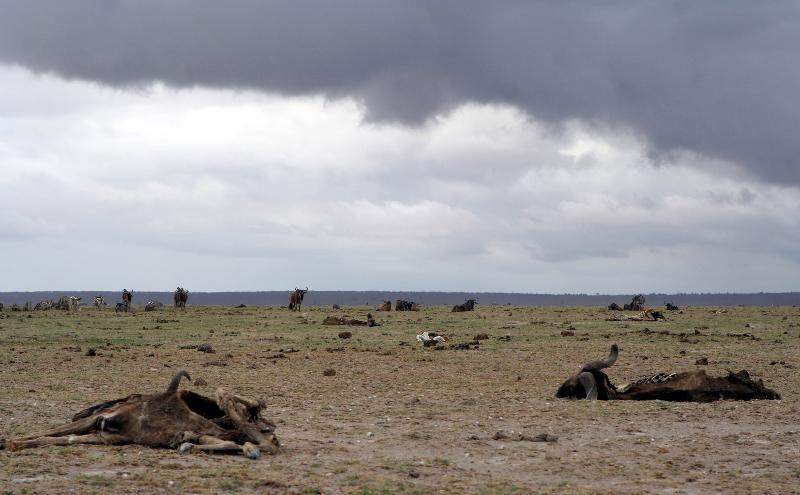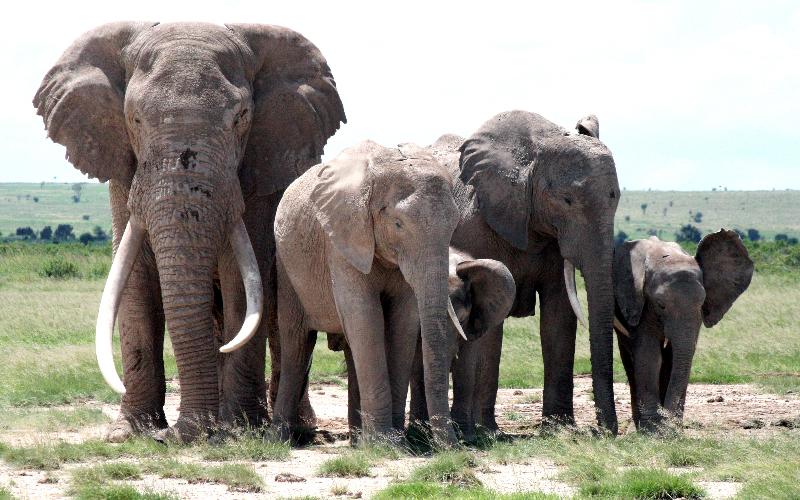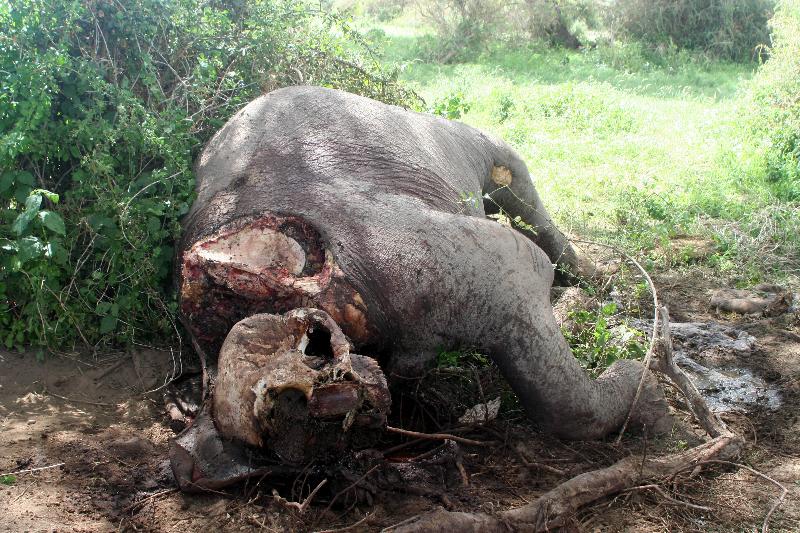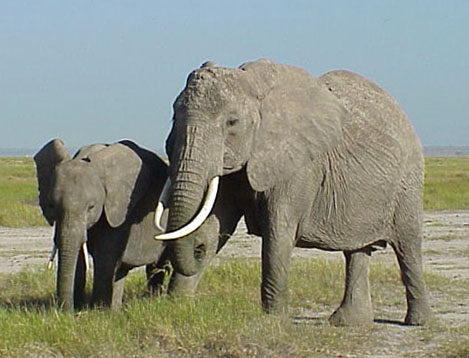|
The Drought of 2009
Dry Amboseli  |
Last year
Amboseli -- elephants and other wildlife, people and livestock --
underwent the worst drought in living memory, the culmination of three
years of poor rainfall. By the start of the dry season of the third year, September 2009, animals began to die in in large numbers. Soon there were
carcasses everywhere strewn over the dry, barren ground. It was truly a
horrific sight, hard on everyone who had to witness it.
In December
rains finally came to areas outside the Park and then in the Park in January.
Good rains continued to fall for the next few months. Vegetation was soon
growing and the landscape was transformed.
In early
March the Kenya Wildlife Service together with the Tanzanian wildlife
authorities and NGOs including the Amboseli Trust for Elephants, conducted a
total aerial count of the greater Amboseli ecosystem. The results revealed that
83% of the wildebeests, 71% of the zebras, and 61% of the buffaloes perished. Over
the whole ecosystem 60% of the cattle died and in the areas around Amboseli the
loss was as high as 80%.
The
elephants were not spared. We are still collecting data on the mortalities as
the families and bulls are sighted in the Park and can be censused. So far we
know that close to 300 elephants (almost 20% of the population) died. Most
tragically this number included at least 60 adult females, many of them
matriarchs, a devastating loss because they were the leaders and repositories
of knowledge for their families.
These old
females were individuals we had known since the early 70s and losing them felt
like losing old friends. As painful as it has been we need to continue the
research. We must watch carefully to see how each family reacts to its losses. Who
will become the new matriarch? Will the others follow her lead or will
sub-groups splinter off? Will some families with few remaining members join up
with other families? Will orphans find a place within their family or move on
their own? How quickly will females recover and start breeding again? The data
we will collect over the next year is vital for our understanding of the social
dynamics and reproduction recovery among elephants. For these reasons it is
important that the families and independent bulls be monitored more intensively
than ever.
We need funds for monitoring and are asking
for your help for the following:
- One
vehicle dedicated exclusively to monitoring at least six days a week
- One
year = $9.000
- One month = $750
- One day = $30
- One
highly experienced researcher out at least six days a week carrying out special
censuses and recording grouping patterns and social and sexual behavior
- One year = $12,000
- One month = $1,000
- One day = $40
Let's hope
this is a once-in-100-years' opportunity to witness this kind of social disruption
in an elephant population. We don't want the elephants ever to undergo a
drought like this one again, but at the same time we must learn as much from it
as we can. We need your help to do this.
|
|
The Upsurge in Poaching and Illegal Ivory Trade
Amboseli's Magnificent Bulls are in Danger
 |
On top of
the drought, poaching of elephants for their ivory started up again after
nearly 20 years of peace for Kenya's elephants. After the ban in international
ivory trade was implemented in January 1990, poaching all but stopped in Kenya
and elephant numbers slowly began to rise. Then in 2008 a few months after
China was allowed to buy ivory stockpiles from some of the southern African
countries that had had their bans lifted, we began to get disturbing reports of
people requesting to purchase ivory. We believe that the stockpile sales
started a demand in China. With many Chinese companies working in Kenya we heard
that ivory was being bought by the Chinese workers. At the same time the
interceptions of shipments of tons of illegal ivory were reported in Thailand,
Vietnam and the Philippines. At the international airport in Nairobi several
shipments of ivory were stopped with the aid of sniffer dogs. Most of this
ivory appeared to come from outside the country.
In 2008 we recorded nine definite cases of tusks being removed from
elephants who may have been poached or died of other causes. This was the first time ivory had
been stolen from carcases in Amboseli for many years. In the first months of
2009 there began to be definite cases of poaching in the Amboseli ecosystem and
in nearby Tsavo. Additional reports of poaching were coming in from other parts
of Kenya. The official poaching figures for Kenya from the Kenya Wildlife
Service (KWS) revealed that 47 elephants were poached in 2007; 145 in 2008; and
204 in 2009. This increase was very
disturbing for all of us concerned with elephant conservation. No one wanted a
repeat of the horrific time in the 1970s and 1980s when Kenya lost 85% of her
elephants.
KWS is working hard at both the ground level and through regional and
international forums to try to stem the poaching. In Amboseli we are doing what
we can, but we desperately need more support to stop the local trade in
ivory before it gets deep into the economy. Amboseli National Park is
only 150 square miles; the ecosystem over which the elephants roam is 5000
square miles. On any given day, of the 1200 elephants making up the population
only about 300 might be in the Park itself. Therefore, it is necessary to secure
the whole Amboseli ecosystem, not just the Park. For the moment the Maasai are
on our side, but if there are people out there asking for tusks and paying huge
amounts for them, then we could lose the battle.
There is no doubt that it is the attitude of the local people that really makes all the difference. What exists now on the community level is a force of about 90 Maasai anti-poaching scouts in the areas surrounding Amboseli. They form the Amboseli-Tsavo Game Scouts Association (ATGSA), but they are miserably under-funded. Two months ago two strategic scouts' camps had to be closed down for lack of money for salaries and rations. These two camps are south of Amboseli National Park on the border with Tanzania. With this international border so close it is easy for poachers to come across, kill one of the Amboseli elephants, and go back into Tanzania where there are networks of buyers and smugglers
We can prevent poaching in the
Amboseli area. It happened during the intensive poaching years in 1970s and
1980s. The only place in all of Kenya where the elephant population grew was
Amboseli. It was partly because we researchers were there on the ground and
partly because the Maasai were not killing elephants themselves and did not
allow poaching on their land. Good relations with the Maasai are key and our
community outreach program--providing jobs, incentives and education--is
essential.
 There are two ways in which you can help protect the elephants: There are two ways in which you can help protect the elephants:
1) We need to support the ATGSA anti-poaching scouts. In particular we want to
get the two camps on the border set up and running again. The cost of running two
camps:
- One year = $29,280
- One month = $2,440
- One day = $80
2) The Amboseli Trust for Elephants has 15 scouts of its own that function both
as researchers and sources of information on poaching and other problems
relating to elephants. They are the ambassadors for elephants out in the Maasai
group ranches and are very important for engendering positive attitudes towards
elephants and the research project. It has and continues to be a very
successful part of our project. To supervise and support 15 research scouts costs:
- One year = $18,120
- One month = $1510
- One day = $60
A donation in any amount will definitely help to keep our wonderful bulls and big females safe.
|
|
Recovery
Erica at 4 years old with her mother Erin
 |
In this
first newsletter and subsequent ones, we promise we won't just send news of
crises and disasters. There are good stories coming out of Amboseli as well. We
are happy to report that the ecosystem got enough rain to turn everything green
and productive once again. The elephants are definitely recovering physically,
even if we don't yet know the long-term social and psychological effects of
losing so many leaders. Some
females miraculously carried calves through the drought and gave birth in 2010.
So far we have recorded 24 births. One of the females was Erica of the EB
family. She is the orphaned daughter of Erin, who died as a result of spearing in
2003, leaving several calves. Erica, who is also Echo's granddaughter, was only
five years old at the time, but the EB family is a very nurturing one, and she
survived along with her younger brother E-Mail. In fact, Erica did well enough
to reach sexual maturity and come into estrus when she was just 10 years
old, which is young (the average is 12) and shows she got the nutrition and
care she needed. Much to our
surprise, given the dreadful conditions of 2009, Erica gave birth in March
2010, which meant she conceived in May 2008 and maintained the 22-month pregnancy
right through the drought. The calf, a female, was small at birth but healthy
and is now five months old. It is hard enough raising a first calf for a young
mother, but much, much harder when that female's mother has died. Well done,
Erica, you have done your mother and grandmother proud.
|